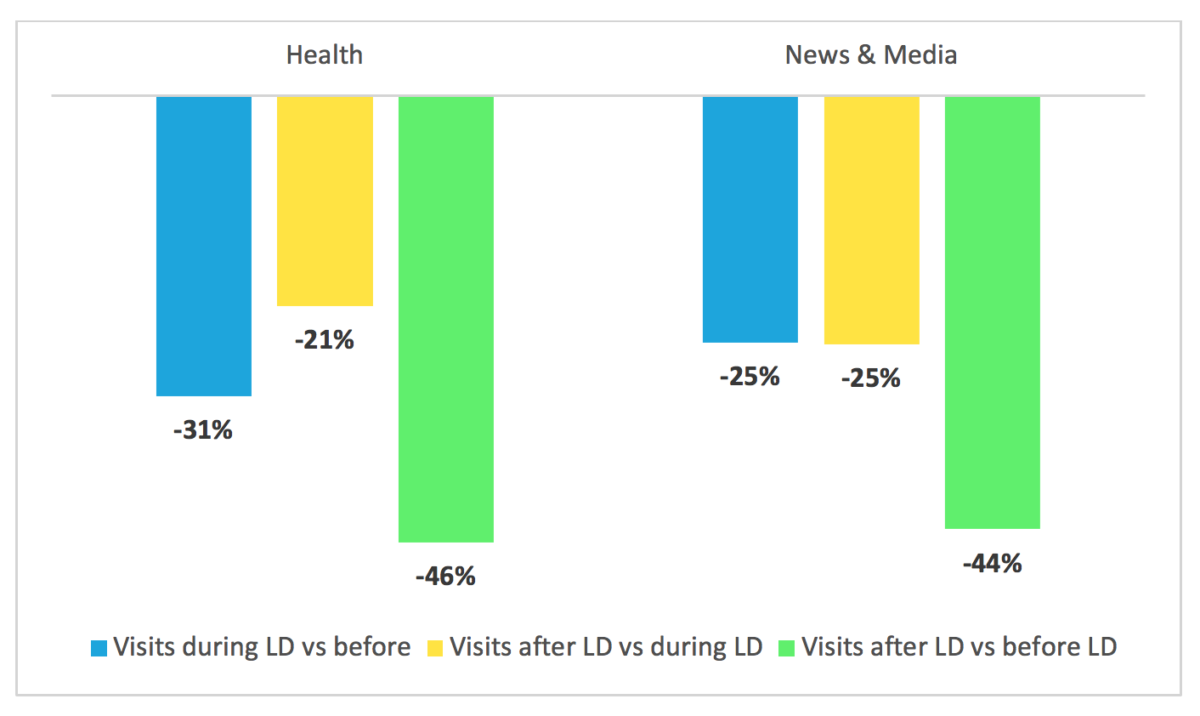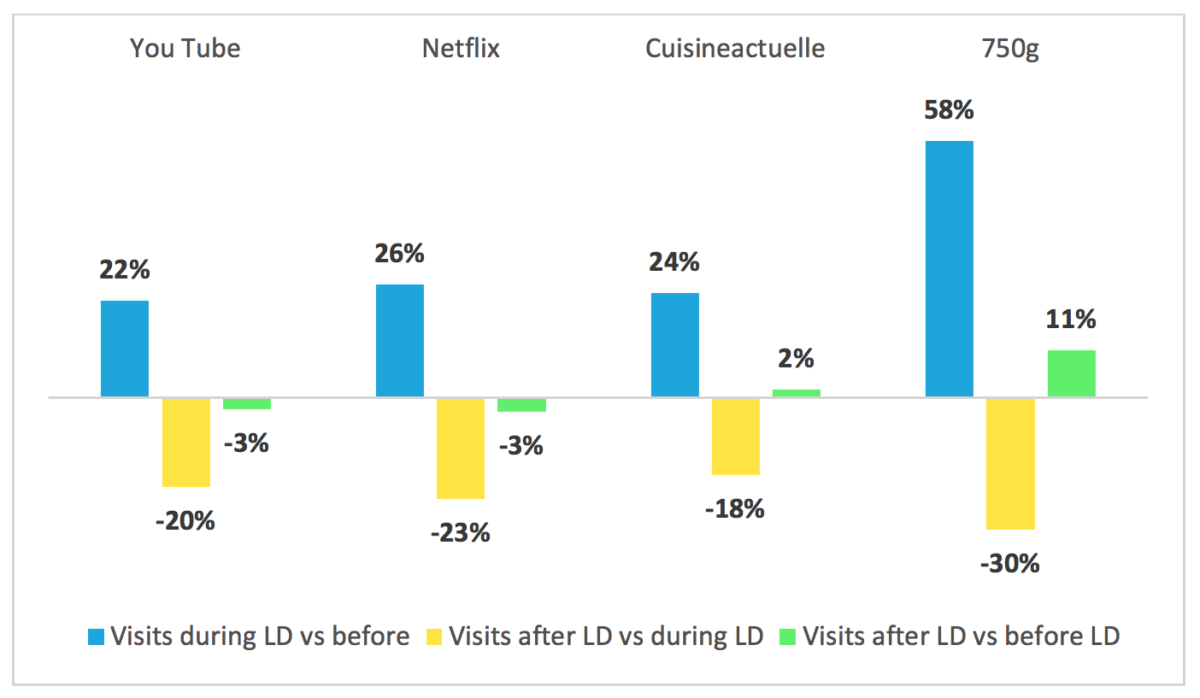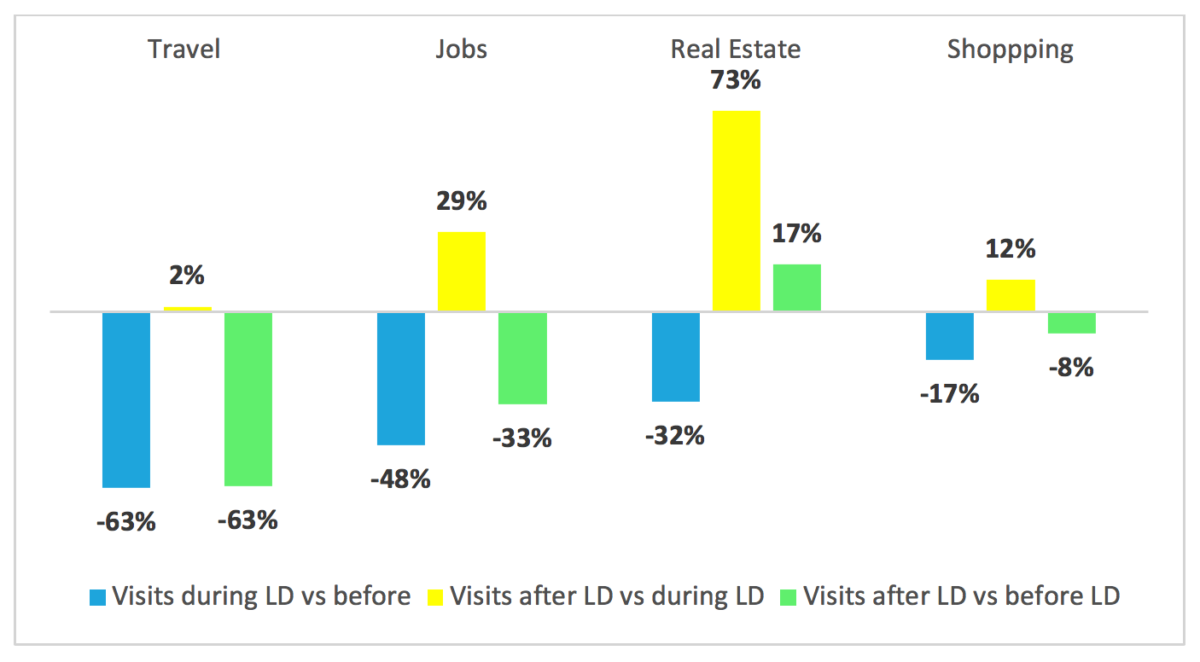The day after – 1st observations in France after the ease of restrictions
Paris. We’re all struggling to understand what the post-COVID-19 world will look like. Although we’re still very much in the COVID-19 world now, we can already see, with the easing of lockdown, the impact COVID-19 will have on our futures. Here, we look at how online behaviour has changed in France, which eased its lockdown restrictions on 11th May.
By observing web navigation data1, we can compare online behaviour during and after lockdown. In doing so, we observed 4 different situations for websites:
| Decreased number of visitors during lockdown vs. before lockdown | Increased number of visitors during lockdown vs. before lockdown | |
| Decreased number of visitors after lockdown vs. during lockdown | 1. Negatively impacted | 2. Back to (new?) normal |
| Increased number of visitors after lockdown vs. during lockdown | 3. Recovery | 4. Positively impacted |
1. Negatively impacted
Some website categories experienced decreasing number of visits both: 1) during lockdown vs. before lockdown 2) after lockdown vs. during lockdown. Surprisingly, both health and news & media were two of these categories.

We analysed three main French news website’s reach (Lemonde.fr; lefigaro.fr, and doctissimo.fr – the most important health related forum). For all these websites, we found the same pattern which explains the category level result: people have been bombarded with information about COVID-19. At the beginning, people wanted as much information as possible. However, after a while (at the end of March), people had all the information they needed about the crisis, and as the news was still focused on the situation.
2. Back to (new?) normal
Some websites were intensely visited during lockdown, as the range of possible leisure distractions was limited: easy and convenient ways of being entertained were to watch TV shows or movies. Now France has more entertainment options available (such as meeting friends), and/or can return to work. Resultantly, there’s less visits to entertainment websites than there were during lockdown.
The same dynamic can be observed for food and recipes websites. These websites had increased visits during lockdown. Currently, either because we’re at home less, or because we have less time for cooking, visits to food and recipe websites have decreased.
However, the situation isn’t the same for entertainment and food websites. Despite peaking during lockdown, visits to entertainment websites are currently lower than before lockdown (people might be attracted to outdoor activities now possible). This is shown by YouTube and Netflix’s website traffic. While visits to food and recipe websites have decreased since the lockdown was eased, it’s still higher than before lockdown.

Do these results tell us something about what the world will look like in the next few months? Will there be an increased digitalization of our leisure activities?
3. Recovery
Some industries have been stopped by lockdown (most notably travel & tourism) industry. With lockdown being eased, French people can “organize” their summer holidays. Resultantly, activity in the travel & tourism industry is now slowly restarting. The same applies to shopping websites. People saved money during lockdown and they’re now taking advantage of it. However, the number of visits to travel and shopping websites is lower than before lockdown.

The same applies for visits to job search and real estate websites. Visits stopped during lockdown by necessity, but now the searches have now recommenced.
4. Positive impact
Finally, there are some websites positively impacted by the lockdown. These are websites where their number of visitors increased during lockdown vs. before lockdown and after lockdown vs. during lockdown.
Courier services are being used more after lockdown vs. before. This is because shops are still reopening or because people are still hesitating to visit offline shops. Then DIY retailers: DIY has been one of the major activities during lockdown, people are still visiting DIY websites as they may need DIY supplies, or still have some jobs to finish.
Self- training services continue to be popular. Many people used the lockdown period to learn a foreign language and they haven’t given up despite an ease in restrictions.

We can already see that some trends started during lockdown have continued: DIY and self-training are still trending activities. Will these be part of the “new normal” or will they too soon disappear like the lockdown fad of home cooking?
1. Since 2016, part of our French panel has accepted to share their navigation/app usage data with us. They all have installed a software/an app which monitors their online activities. Here we compared the measures obtained since the 1st March 2020. Nationally representative sample (gender, age) n=1,983, data from desktop and mobile (besides apps).


